warning DODGE DURANGO 2004 2.G Owner's Manual
[x] Cancel search | Manufacturer: DODGE, Model Year: 2004, Model line: DURANGO, Model: DODGE DURANGO 2004 2.GPages: 386, PDF Size: 6.22 MB
Page 46 of 386

under the seat and interferes with operation of the weight
sensors, a fault will occur which turns on both the PAD
Indicator Light and the Airbag Warning Light. Once the
lodged object is removed, the fault will be automatically
cleared after a short period of time.²TheDriver and Passenger Airbag/Inflator Unitsare
located in the center of the steering wheel and the right
side of the instrument panel. When the ORC detects a
collision requiring the airbags, it signals the inflator
units. A large quantity of nontoxic gas is generated to
inflate the front airbags. Different airbag inflation rates
may be possible based on collision severity and occu-
pant size. The steering wheel hub trim cover and the
upper right side of the instrument panel separate and
fold out of the way as the bags inflate to their full size.
The bags fully inflate in about 50 - 70 milliseconds.
This is about half of the time it takes to blink your eyes.
The bags then quickly deflate while helping to restrain
the driver and front passenger. The driver's front
airbag gas is vented through vent holes in the sides of
the airbag. The passenger's front airbag gas is vented
through vent holes in the sides of the airbag. In this
way the airbags do not interfere with your control of
the vehicle.
Passenger Airbag Off Indicator
46 THINGS TO KNOW BEFORE STARTING YOUR VEHICLE
Page 49 of 386
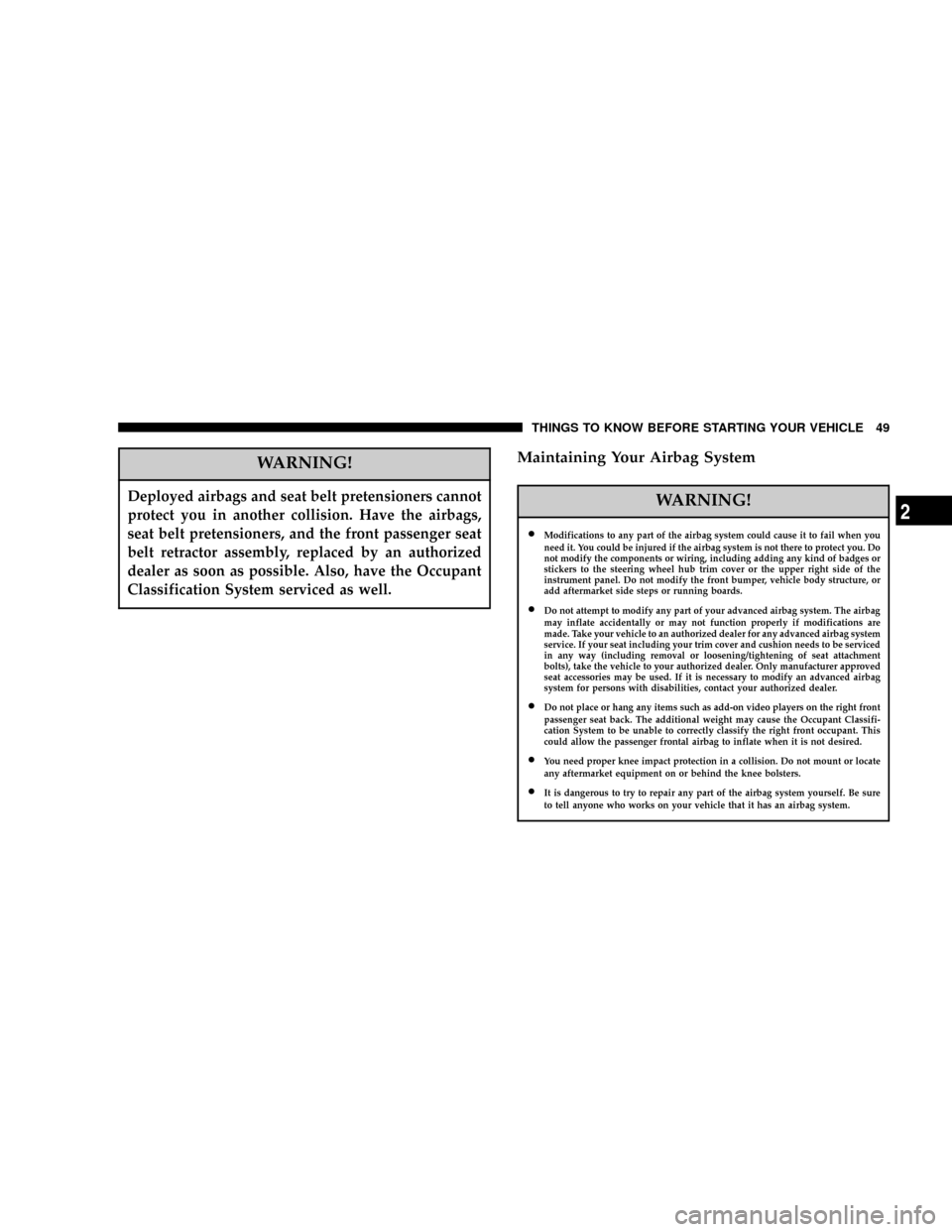
WARNING!
Deployed airbags and seat belt pretensioners cannot
protect you in another collision. Have the airbags,
seat belt pretensioners, and the front passenger seat
belt retractor assembly, replaced by an authorized
dealer as soon as possible. Also, have the Occupant
Classification System serviced as well.
Maintaining Your Airbag System
WARNING!
²Modifications to any part of the airbag system could cause it to fail when you
need it. You could be injured if the airbag system is not there to protect you. Do
not modify the components or wiring, including adding any kind of badges or
stickers to the steering wheel hub trim cover or the upper right side of the
instrument panel. Do not modify the front bumper, vehicle body structure, or
add aftermarket side steps or running boards.
²Do not attempt to modify any part of your advanced airbag system. The airbag
may inflate accidentally or may not function properly if modifications are
made. Take your vehicle to an authorized dealer for any advanced airbag system
service. If your seat including your trim cover and cushion needs to be serviced
in any way (including removal or loosening/tightening of seat attachment
bolts), take the vehicle to your authorized dealer. Only manufacturer approved
seat accessories may be used. If it is necessary to modify an advanced airbag
system for persons with disabilities, contact your authorized dealer.
²Do not place or hang any items such as add-on video players on the right front
passenger seat back. The additional weight may cause the Occupant Classifi-
cation System to be unable to correctly classify the right front occupant. This
could allow the passenger frontal airbag to inflate when it is not desired.
²You need proper knee impact protection in a collision. Do not mount or locate
any aftermarket equipment on or behind the knee bolsters.
²It is dangerous to try to repair any part of the airbag system yourself. Be sure
to tell anyone who works on your vehicle that it has an airbag system.
THINGS TO KNOW BEFORE STARTING YOUR VEHICLE 49
2
Page 52 of 386
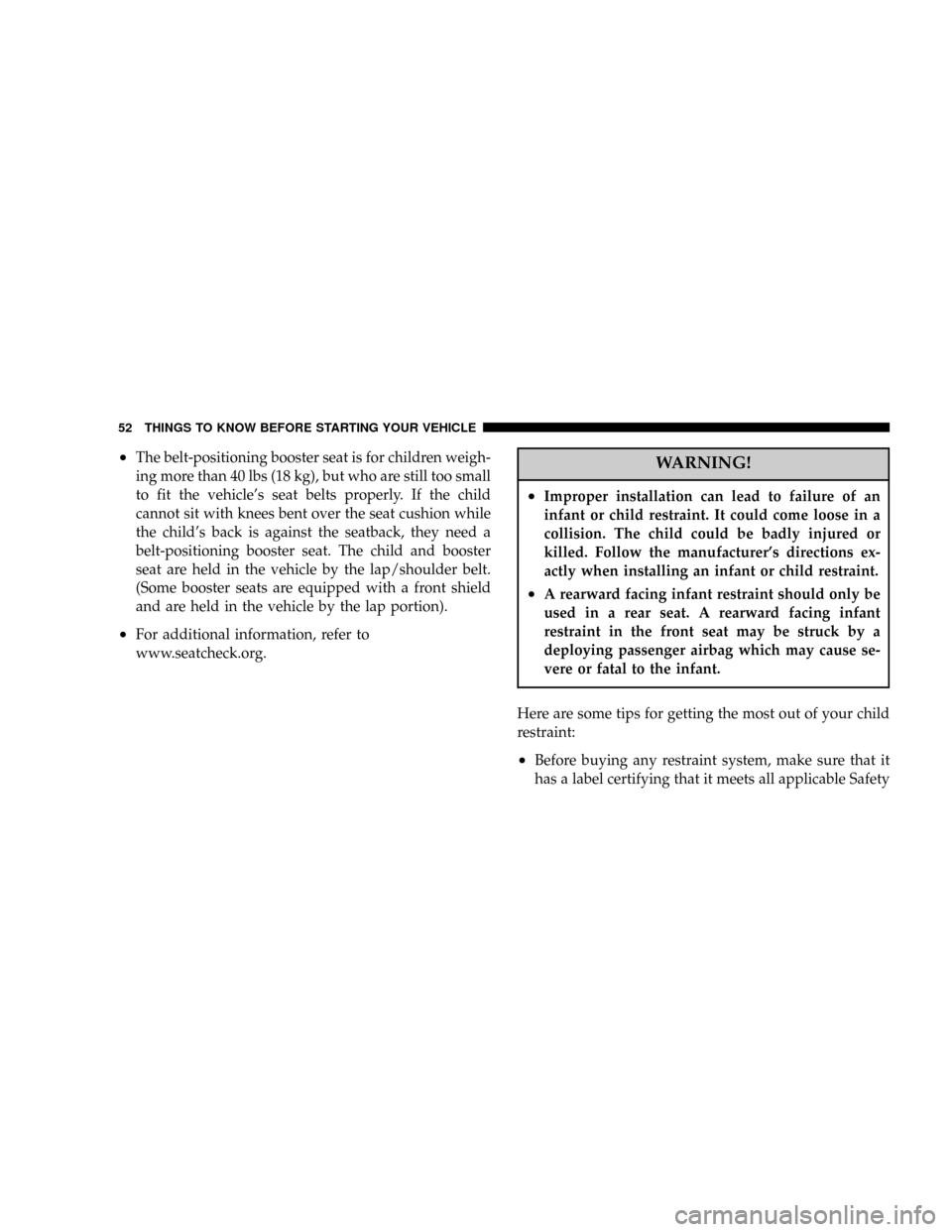
²The belt-positioning booster seat is for children weigh-
ing more than 40 lbs (18 kg), but who are still too small
to fit the vehicle's seat belts properly. If the child
cannot sit with knees bent over the seat cushion while
the child's back is against the seatback, they need a
belt-positioning booster seat. The child and booster
seat are held in the vehicle by the lap/shoulder belt.
(Some booster seats are equipped with a front shield
and are held in the vehicle by the lap portion).
²For additional information, refer to
www.seatcheck.org.
WARNING!
²Improper installation can lead to failure of an
infant or child restraint. It could come loose in a
collision. The child could be badly injured or
killed. Follow the manufacturer's directions ex-
actly when installing an infant or child restraint.
²A rearward facing infant restraint should only be
used in a rear seat. A rearward facing infant
restraint in the front seat may be struck by a
deploying passenger airbag which may cause se-
vere or fatal to the infant.
Here are some tips for getting the most out of your child
restraint:
²Before buying any restraint system, make sure that it
has a label certifying that it meets all applicable Safety
52 THINGS TO KNOW BEFORE STARTING YOUR VEHICLE
Page 57 of 386
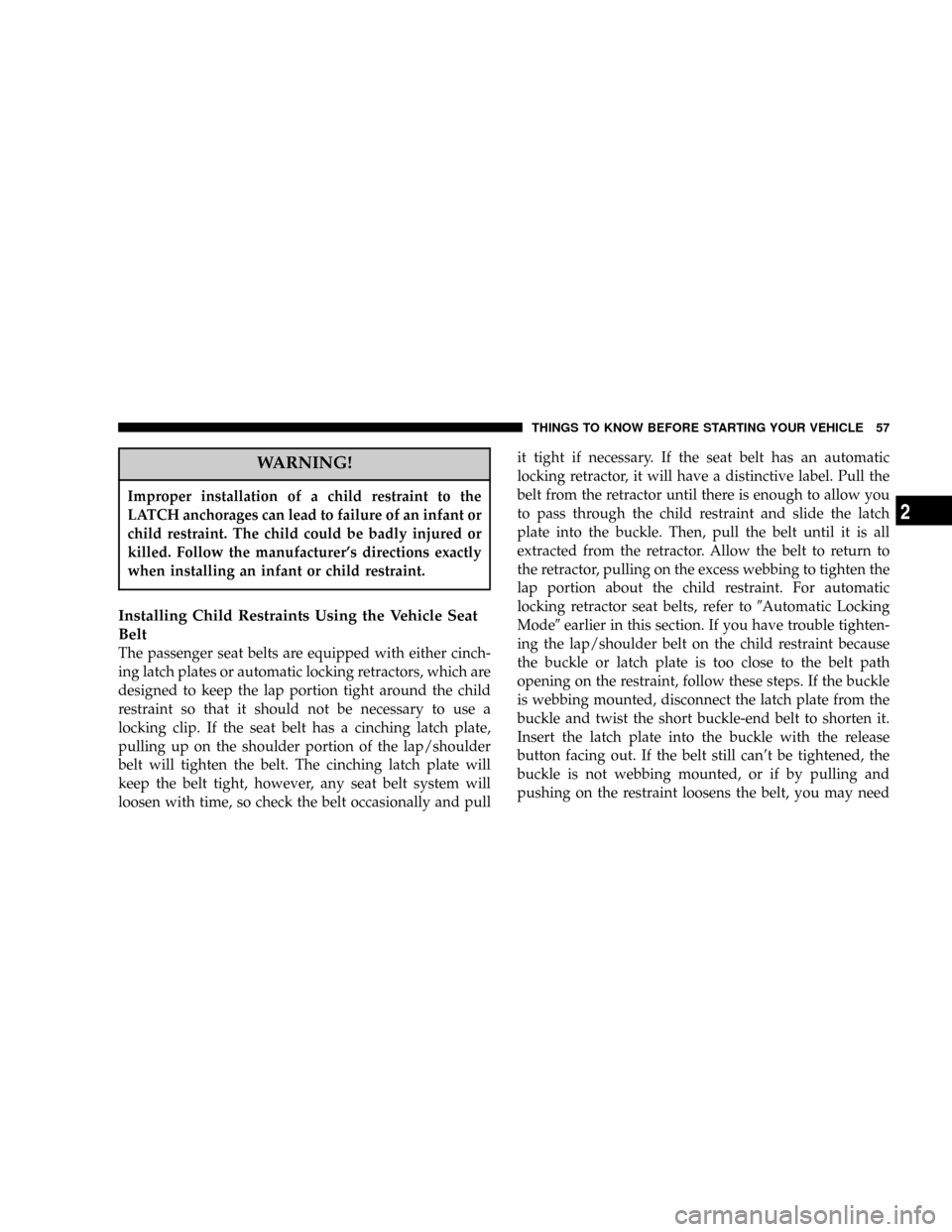
WARNING!
Improper installation of a child restraint to the
LATCH anchorages can lead to failure of an infant or
child restraint. The child could be badly injured or
killed. Follow the manufacturer's directions exactly
when installing an infant or child restraint.
Installing Child Restraints Using the Vehicle Seat
Belt
The passenger seat belts are equipped with either cinch-
ing latch plates or automatic locking retractors, which are
designed to keep the lap portion tight around the child
restraint so that it should not be necessary to use a
locking clip. If the seat belt has a cinching latch plate,
pulling up on the shoulder portion of the lap/shoulder
belt will tighten the belt. The cinching latch plate will
keep the belt tight, however, any seat belt system will
loosen with time, so check the belt occasionally and pullit tight if necessary. If the seat belt has an automatic
locking retractor, it will have a distinctive label. Pull the
belt from the retractor until there is enough to allow you
to pass through the child restraint and slide the latch
plate into the buckle. Then, pull the belt until it is all
extracted from the retractor. Allow the belt to return to
the retractor, pulling on the excess webbing to tighten the
lap portion about the child restraint. For automatic
locking retractor seat belts, refer to9Automatic Locking
Mode9earlier in this section. If you have trouble tighten-
ing the lap/shoulder belt on the child restraint because
the buckle or latch plate is too close to the belt path
opening on the restraint, follow these steps. If the buckle
is webbing mounted, disconnect the latch plate from the
buckle and twist the short buckle-end belt to shorten it.
Insert the latch plate into the buckle with the release
button facing out. If the belt still can't be tightened, the
buckle is not webbing mounted, or if by pulling and
pushing on the restraint loosens the belt, you may need
THINGS TO KNOW BEFORE STARTING YOUR VEHICLE 57
2
Page 60 of 386

Child Restraints in Third Row Seating (If
Equipped)
The third seating row is not capable of installing child
restraints that require the use of a tether strap. There are
no tether anchor provisions for the third seating row in
your vehicle, the hooks in the rear floor are not designed
to withstand the forces that may occur during a crash.
WARNING!
An incorrectly anchored tether strap could lead to
increased head motion and possible injury to the
child. Use only the anchor positions directly behind
the child seat to secure a child restraint top tether
strap. Do not install a child restraint that requires a
tether strap in the third seating row (if equipped) of
this vehicle.
Child Restraint Tether Anchor
There are tether strap anchorages behind each seating
position in the second row. For vehicles equipped with
third row seating, there is no Child Tether Anchorage
provided for the third row of seats. To install child
restraint tethers follow these instructions.
1. Place the child restraint in the second row of seats.
2. Route the tether strap under the head restraint and
between the two posts.
3. Attach the tether strap hook of the child restraint to
the tether anchor located on the seat back and remove the
slack in the tether strap according to the manufacturer's
instructions.
60 THINGS TO KNOW BEFORE STARTING YOUR VEHICLE
Page 61 of 386
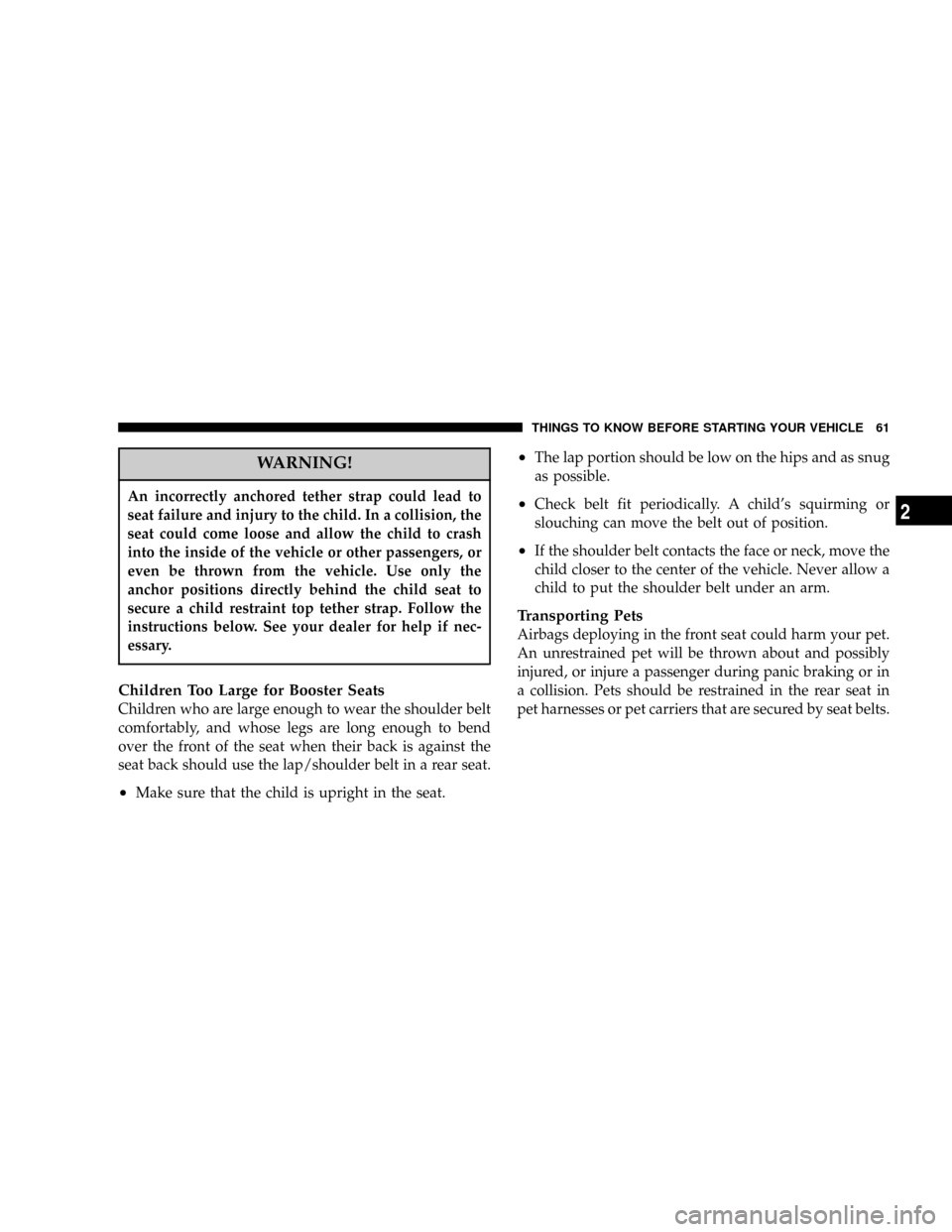
WARNING!
An incorrectly anchored tether strap could lead to
seat failure and injury to the child. In a collision, the
seat could come loose and allow the child to crash
into the inside of the vehicle or other passengers, or
even be thrown from the vehicle. Use only the
anchor positions directly behind the child seat to
secure a child restraint top tether strap. Follow the
instructions below. See your dealer for help if nec-
essary.
Children Too Large for Booster Seats
Children who are large enough to wear the shoulder belt
comfortably, and whose legs are long enough to bend
over the front of the seat when their back is against the
seat back should use the lap/shoulder belt in a rear seat.
²Make sure that the child is upright in the seat.
²The lap portion should be low on the hips and as snug
as possible.
²Check belt fit periodically. A child's squirming or
slouching can move the belt out of position.
²If the shoulder belt contacts the face or neck, move the
child closer to the center of the vehicle. Never allow a
child to put the shoulder belt under an arm.
Transporting Pets
Airbags deploying in the front seat could harm your pet.
An unrestrained pet will be thrown about and possibly
injured, or injure a passenger during panic braking or in
a collision. Pets should be restrained in the rear seat in
pet harnesses or pet carriers that are secured by seat belts.
THINGS TO KNOW BEFORE STARTING YOUR VEHICLE 61
2
Page 62 of 386
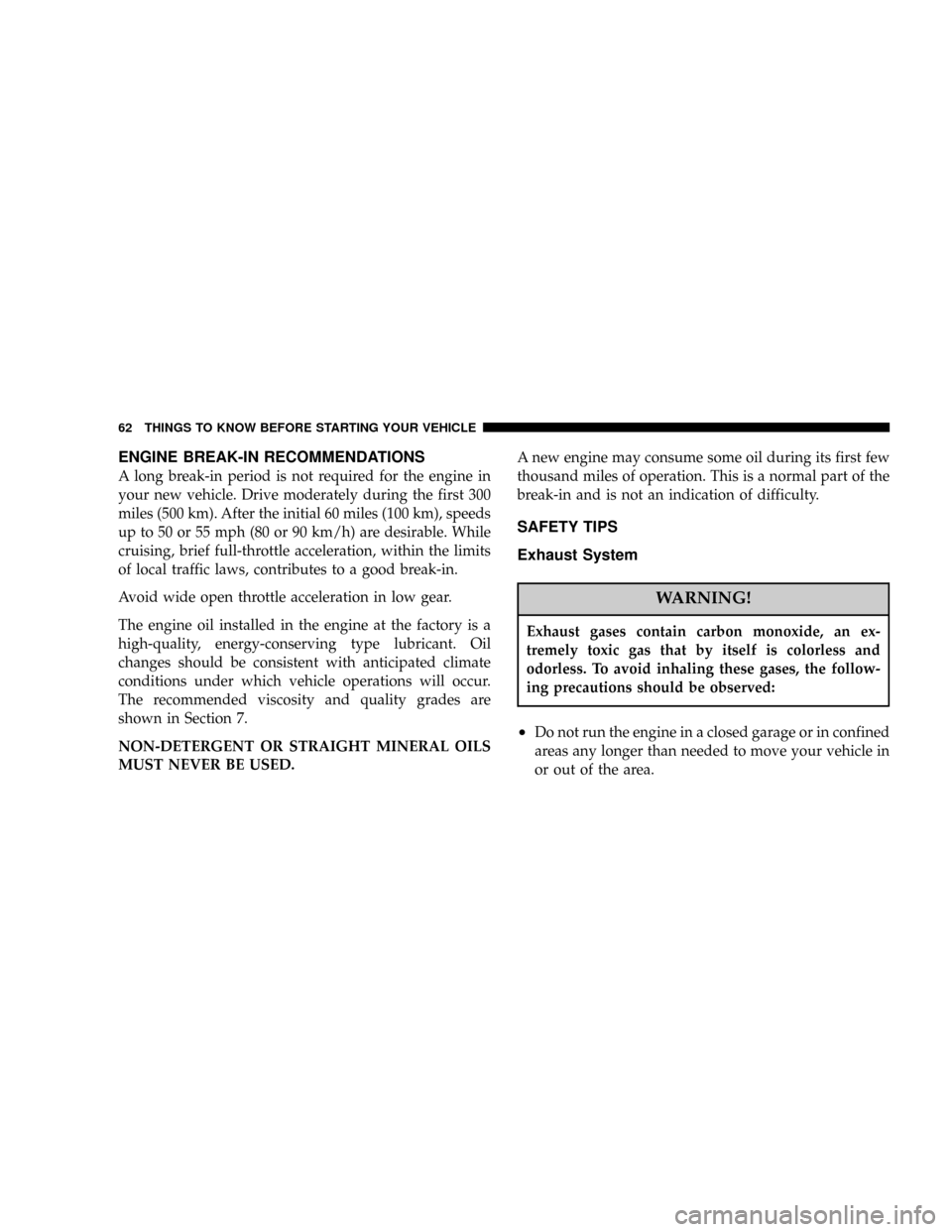
ENGINE BREAK-IN RECOMMENDATIONS
A long break-in period is not required for the engine in
your new vehicle. Drive moderately during the first 300
miles (500 km). After the initial 60 miles (100 km), speeds
up to 50 or 55 mph (80 or 90 km/h) are desirable. While
cruising, brief full-throttle acceleration, within the limits
of local traffic laws, contributes to a good break-in.
Avoid wide open throttle acceleration in low gear.
The engine oil installed in the engine at the factory is a
high-quality, energy-conserving type lubricant. Oil
changes should be consistent with anticipated climate
conditions under which vehicle operations will occur.
The recommended viscosity and quality grades are
shown in Section 7.
NON-DETERGENT OR STRAIGHT MINERAL OILS
MUST NEVER BE USED.A new engine may consume some oil during its first few
thousand miles of operation. This is a normal part of the
break-in and is not an indication of difficulty.
SAFETY TIPS
Exhaust System
WARNING!
Exhaust gases contain carbon monoxide, an ex-
tremely toxic gas that by itself is colorless and
odorless. To avoid inhaling these gases, the follow-
ing precautions should be observed:
²Do not run the engine in a closed garage or in confined
areas any longer than needed to move your vehicle in
or out of the area.
62 THINGS TO KNOW BEFORE STARTING YOUR VEHICLE
Page 73 of 386
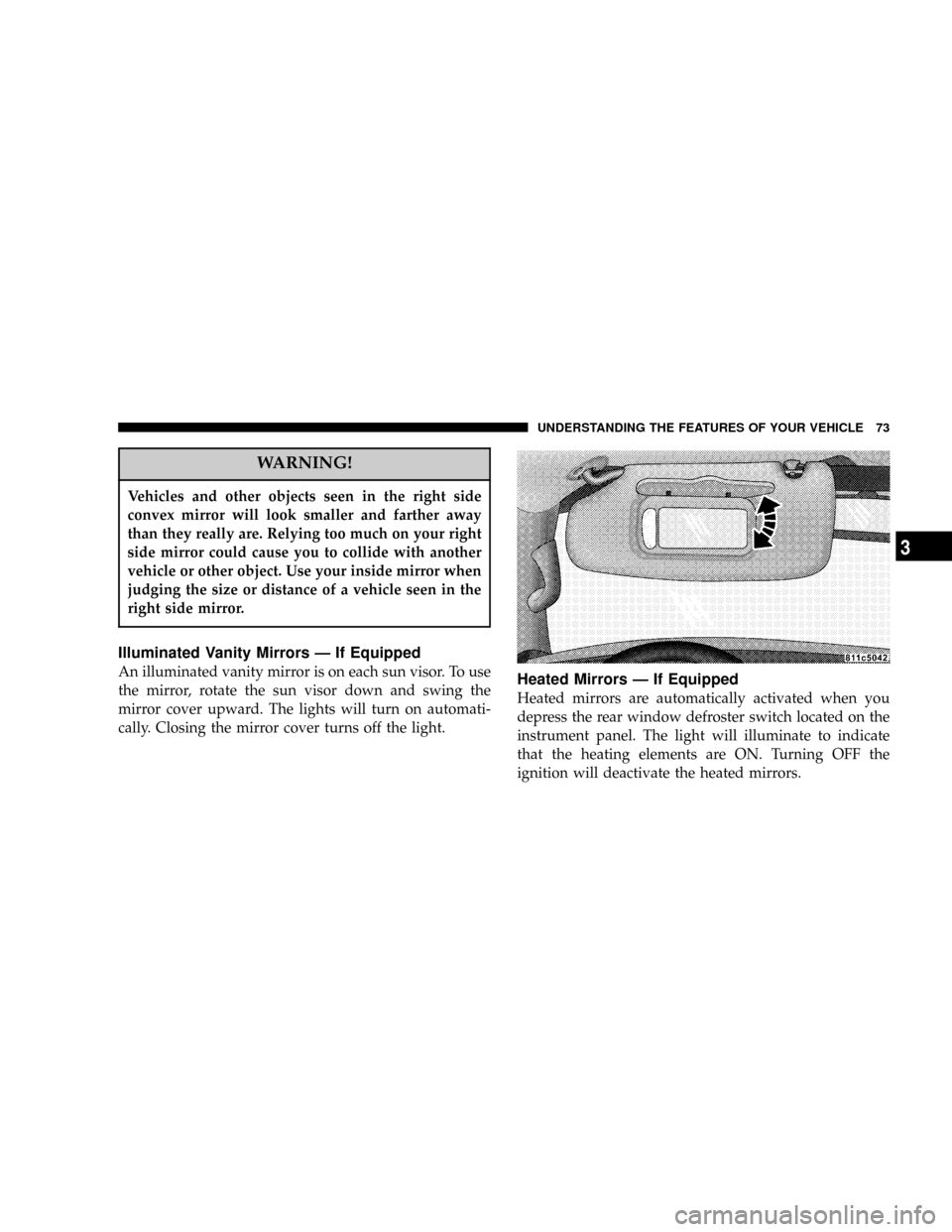
WARNING!
Vehicles and other objects seen in the right side
convex mirror will look smaller and farther away
than they really are. Relying too much on your right
side mirror could cause you to collide with another
vehicle or other object. Use your inside mirror when
judging the size or distance of a vehicle seen in the
right side mirror.
Illuminated Vanity Mirrors Ð If Equipped
An illuminated vanity mirror is on each sun visor. To use
the mirror, rotate the sun visor down and swing the
mirror cover upward. The lights will turn on automati-
cally. Closing the mirror cover turns off the light.Heated Mirrors Ð If Equipped
Heated mirrors are automatically activated when you
depress the rear window defroster switch located on the
instrument panel. The light will illuminate to indicate
that the heating elements are ON. Turning OFF the
ignition will deactivate the heated mirrors.
UNDERSTANDING THE FEATURES OF YOUR VEHICLE 73
3
Page 87 of 386
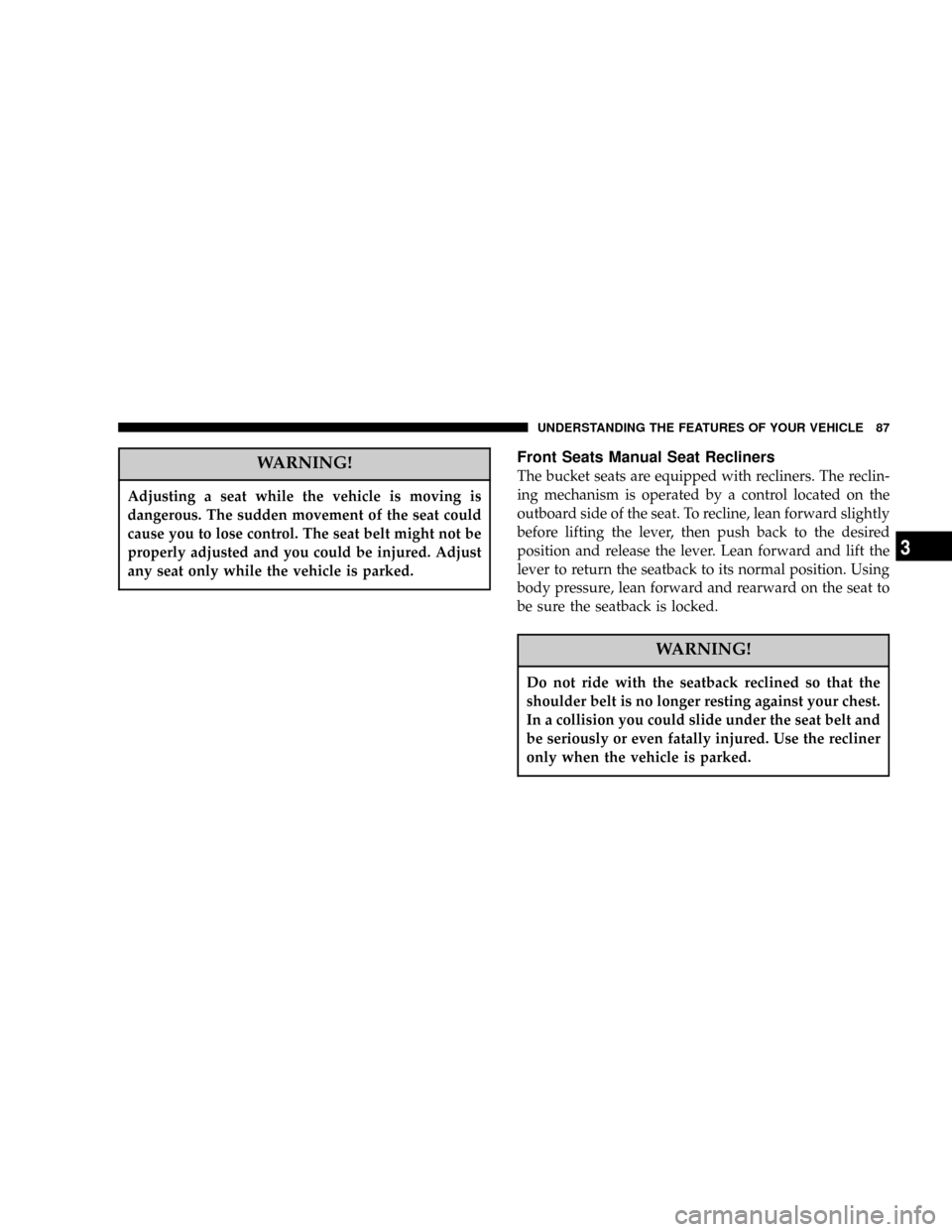
WARNING!
Adjusting a seat while the vehicle is moving is
dangerous. The sudden movement of the seat could
cause you to lose control. The seat belt might not be
properly adjusted and you could be injured. Adjust
any seat only while the vehicle is parked.
Front Seats Manual Seat Recliners
The bucket seats are equipped with recliners. The reclin-
ing mechanism is operated by a control located on the
outboard side of the seat. To recline, lean forward slightly
before lifting the lever, then push back to the desired
position and release the lever. Lean forward and lift the
lever to return the seatback to its normal position. Using
body pressure, lean forward and rearward on the seat to
be sure the seatback is locked.
WARNING!
Do not ride with the seatback reclined so that the
shoulder belt is no longer resting against your chest.
In a collision you could slide under the seat belt and
be seriously or even fatally injured. Use the recliner
only when the vehicle is parked.
UNDERSTANDING THE FEATURES OF YOUR VEHICLE 87
3
Page 95 of 386
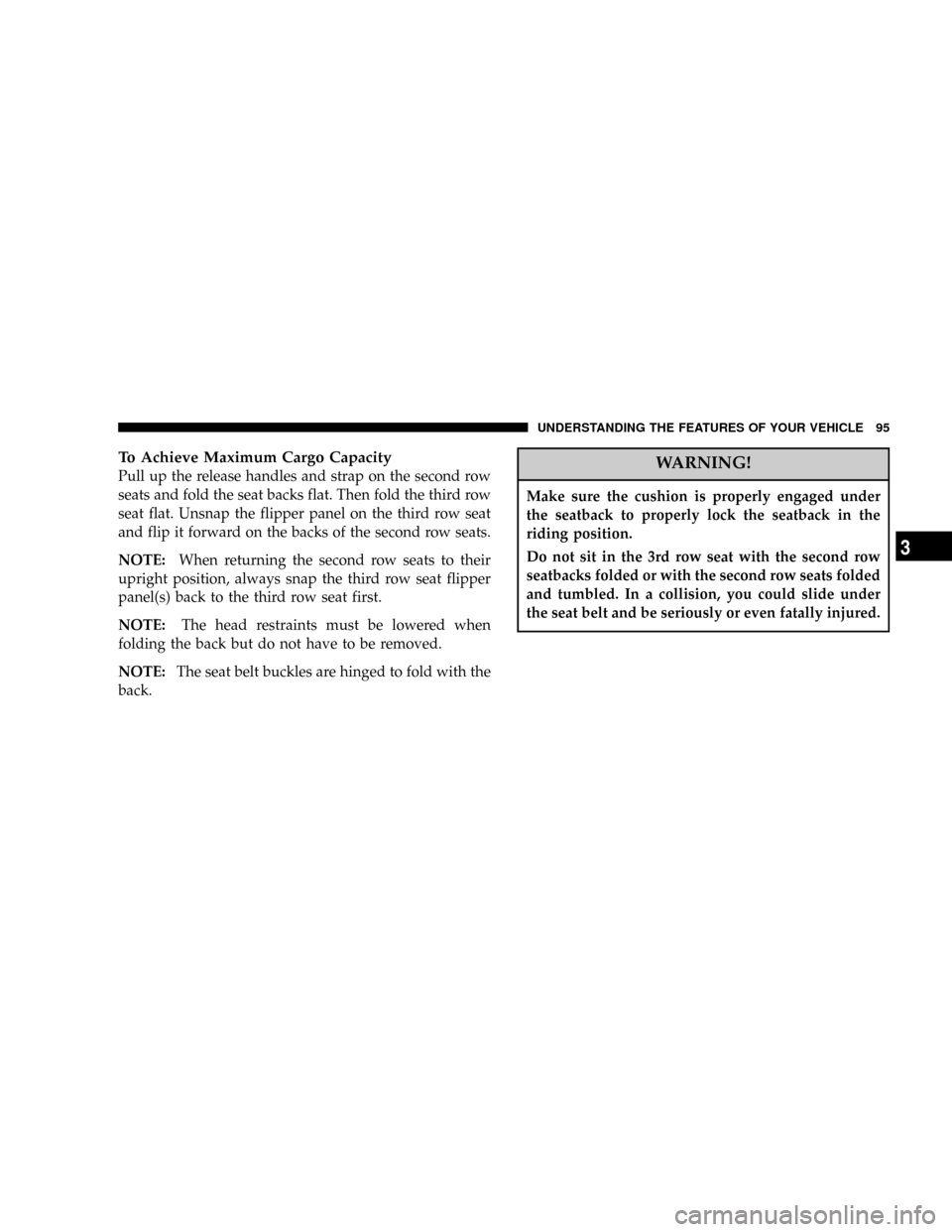
To Achieve Maximum Cargo Capacity
Pull up the release handles and strap on the second row
seats and fold the seat backs flat. Then fold the third row
seat flat. Unsnap the flipper panel on the third row seat
and flip it forward on the backs of the second row seats.
NOTE:When returning the second row seats to their
upright position, always snap the third row seat flipper
panel(s) back to the third row seat first.
NOTE:The head restraints must be lowered when
folding the back but do not have to be removed.
NOTE:The seat belt buckles are hinged to fold with the
back.WARNING!
Make sure the cushion is properly engaged under
the seatback to properly lock the seatback in the
riding position.
Do not sit in the 3rd row seat with the second row
seatbacks folded or with the second row seats folded
and tumbled. In a collision, you could slide under
the seat belt and be seriously or even fatally injured.
UNDERSTANDING THE FEATURES OF YOUR VEHICLE 95
3